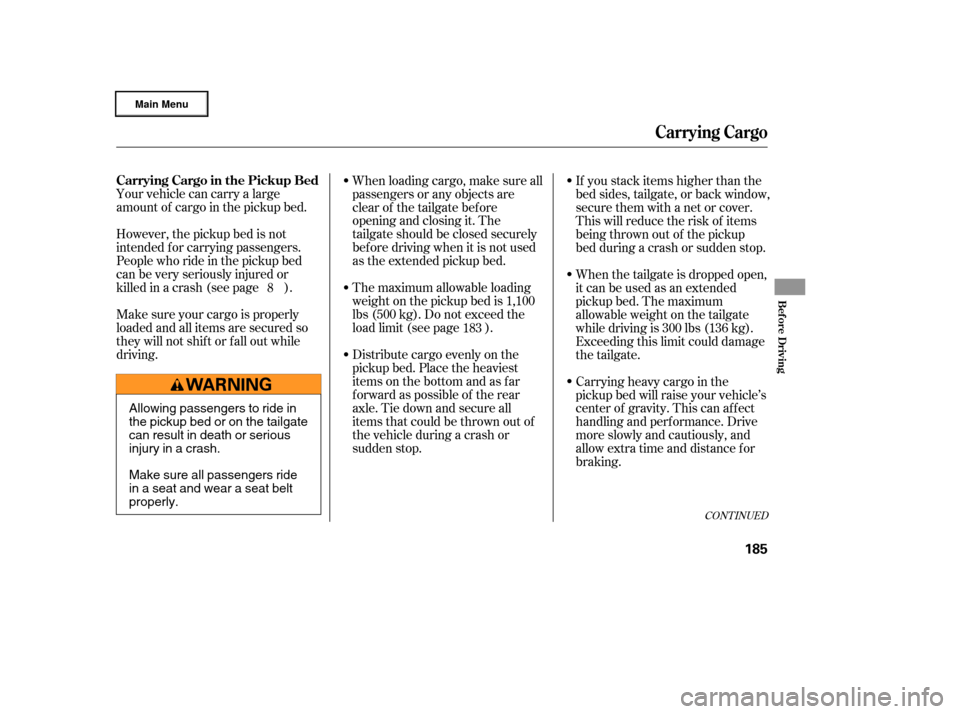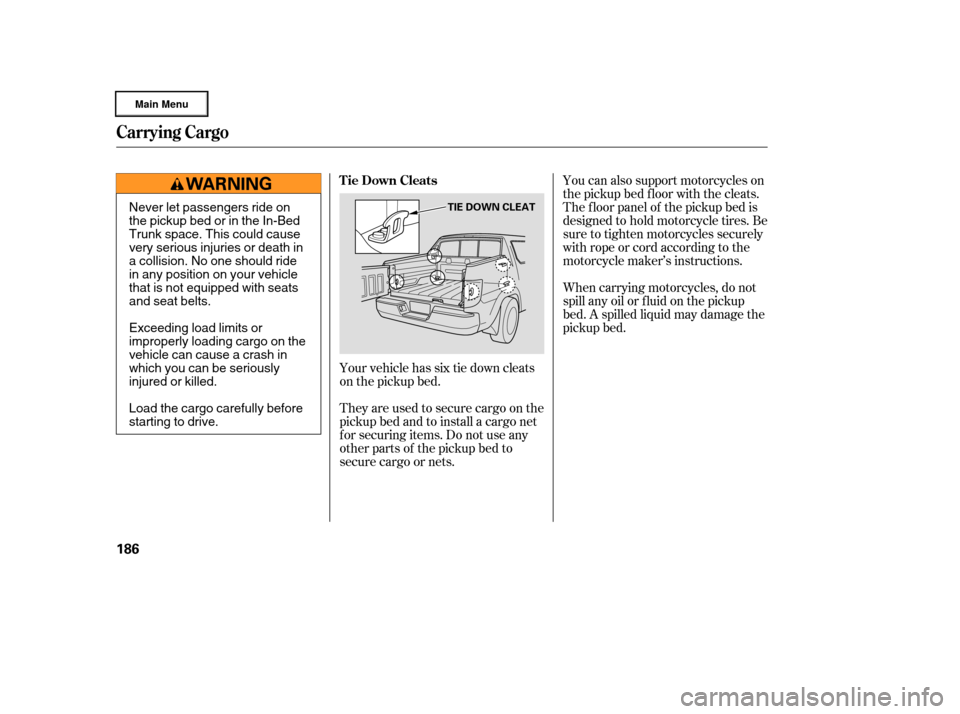Page 62 of 320

The instrument panel has many
indicators to give you important
inf ormation about your vehicle.
If you turn the ignition switch to ON
(II) bef ore f astening your seat belt,
the beeper sounds and the indicator
f lashes. If you do not f asten your
seat belt bef ore the beeper stops, the
indicator stops f lashing but remains
on.
If you continue driving without
f astening your seat belt, the beeper
sounds and the indicator f lashes
again at regular intervals.See page .
The engine can be severely damaged
if this indicator f lashes or stays on
when the engine is running. For
more information, see page .
If this indicator comes on when the
engine is running, the battery is not
being charged. For more inf ormation,
see page .
This indicator comes on when you
turn the ignition switch to ON (II). It
reminds you and your passengers to
f asten your seat belts. A beeper also
sounds if you have not f astened your
seat belt.
This indicator comes on brief ly when
you turn the ignition switch to ON
(II). If it comes on at any other time,
it indicates a potential problem with
your f ront airbags. This indicator will
also alert you to a potential problem
with your side airbags, passenger’s
side airbag automatic cutoff system,
side curtain airbags, rollover sensor,
or automatic seat belt tensioners.
For more inf ormation, see page .
This indicator comes on when you
turn the ignition switch to ON (II). If
it comes on at any other time, it
indicates that the passenger’s side
airbag has automatically shut off.
For more inf ormation, see page .
279
278
278 27
28
Seat Belt Reminder
Indicator
Malf unction Indicator
Lamp
L ow Oil Pressure
Indicator
Charging System
IndicatorSupplemental Restraint
System Indicator
Side Airbag Of f
Indicator
Instrument Panel Indicators
Inst rument s and Cont rols
59
U.S. Canada
�����—�
���—�����y�
���������
���y���
�(�����������y���������y
Page 64 of 320

When you press the hazard warning
button, both turn signal indicators
blink. All turn signals on the outside
of the vehicle should f lash.This monitor includes two f unctions;
the door open indicator and the
tailgate open indicator. This monitor
works with the ignition switch in any
position.
The specif ic door indicator comes on
in this monitor if any door is not
closed tightly.
Thetailgateindicatorcomeson
whenthetailgateisswungopenorif
it is not closed completely af ter you
swing it closed.If the tailgate is swung open or is not
closed tightly, you will hear six beeps
and see the indicator blinking when
you turn the ignition switch to the
ON (II) position. The beeper also
sounds and the indicator blinks when
you move the shif t lever out of Park
or neutral position.
The tailgate open indicator does not
monitor the tailgate when it is
dropped open.
If the driver does not f asten the seat
belt and the tailgate is swung open,
the seat belt reminder alarm will
sound at first, then the tailgate open
reminder beeper will sound.
For more inf ormation on the tailgate,
see page .
The lef t or right turn signal indicator
blinks when you signal a lane change
or turn. If an indicator does not blink
or blinks rapidly, it usually means
one of the turn signal bulbs is
burned out (see pages and ).
Replace the bulb as soon as possible,
since other drivers cannot see that
you are signaling.
91
246
247
Turn Signal and
Hazard Warning
Indicators
Door and T ailgate Open Monitor
Instrument Panel Indicators
Inst rument s and Cont rols
61
�����—�����—�����y�
����
����
���y���
�(�����������y���������y
Page 94 of 320

See page for information on
cargo loading and weight limits.
You can also store and lock items in
the In-Bed Trunk (see page ). If you do not f asten the seat belt, you
f irst hear the seat belt reminder
alarm, then the tailgate reminder
beeper sounds.
The indicator does not monitor the
tailgate when it is dropped open.
This indicator is in the door and
tailgate open monitor on the
instrument panel. It comes on when
the tailgate is swung open or it is not
completely closed. This indicator
worksevenif thekeyisnotinthe
ignition switch.
If the tailgate is swung open or not
closed tightly when the ignition
switch is in the ON (II) position, you
will hear six beeps and see the
indicator blinking. The indicator
stays on until you close the tailgate.
The beeper also sounds and the
indicator blinks when you move the
shif t lever out of the Park or neutral
position.
Do not allow anyone to hang on the
swung open tailgate. This could
damage the tailgate.
Do not leave the tailgate swung open.
The tailgate may swing and shut
accidentally. This could cause
serious injuries.
Thebedlightscomeonwhenyou
swing open the tailgate. You can also
turn the bed lights on or off by
pushing the bed light switch on the
dashboard (see page ).
183
117 92
Dual-Action Tailgate
Loading Cargo
T ailgat e Open Indicat or
Inst rument s and Cont rols
91
�����—�
���—�����y�
�������������y���
�(�����������y���������y
Page 115 of 320
Open the glove box by pulling the
handle. Close it with a f irm push.
Lock or unlock the glove box with
the master key.
The glove box light comes on when
the parking lights are on.Some larger styles of sunglasses
may not f it in the holder.
These hooks are not designed f or
large or heavy items.
To open the sunglasses holder, push
on the rear edge. Make sure the
holder is closed while you are driving.
Glove Box
Sunglasses Holder
Coat Hooks
Interior Convenience Items
112
SUNGLASSES HOLDER
An open glove box can cause
serious injury to your passenger
inacrash,evenifthe
passenger is wearing the seat
belt.
Always keep the glove box
closed while driving.
�����—�
���—�����y�
���������
�
�y���
�(�����������y���
�
���y
Page 188 of 320

CONT INUED
Your vehicle can carry a large
amount of cargo in the pickup bed.
However, the pickup bed is not
intended f or carrying passengers.
Peoplewhorideinthepickupbed
can be very seriously injured or
killed in a crash (see page ).
Make sure your cargo is properly
loaded and all items are secured so
they will not shif t or f all out while
driving.When loading cargo, make sure all
passengers or any objects are
clear of the tailgate bef ore
opening and closing it. The
tailgate should be closed securely
bef ore driving when it is not used
as the extended pickup bed.
The maximum allowable loading
weight on the pickup bed is 1,100
lbs (500 kg). Do not exceed the
load limit (see page ).
Distribute cargo evenly on the
pickup bed. Place the heaviest
items on the bottom and as f ar
f orward as possible of the rear
axle. Tie down and secure all
items that could be thrown out of
the vehicle during a crash or
sudden stop.If you stack items higher than the
bed sides, tailgate, or back window,
secure them with a net or cover.
This will reduce the risk of items
beingthrownoutof thepickup
bed during a crash or sudden stop.
When the tailgate is dropped open,
itcanbeusedasanextended
pickup bed. The maximum
allowable weight on the tailgate
while driving is 300 lbs (136 kg).
Exceeding this limit could damage
the tailgate.
Carrying heavy cargo in the
pickup bed will raise your vehicle’s
center of gravity. This can affect
handling and perf ormance. Drive
more slowly and cautiously, and
allow extra time and distance f or
braking.
8
183
Carrying Cargo
Carrying Cargo in the Pickup Bed
Bef ore Driving
185
Allowing passengers to ride in
the pickup bed or on the tailgate
can result in death or serious
injury in a crash.
Make sure all passengers ride
in a seat and wear a seat belt
properly.
�����—�����—�����y�
����
��������y���
�(�����������y���
�����y
Page 189 of 320

Your vehicle has six tie down cleats
on the pickup bed.You can also support motorcycles on
the pickup bed floor with the cleats.
The f loor panel of the pickup bed is
designed to hold motorcycle tires. Be
sure to tighten motorcycles securely
with rope or cord according to the
motorcycle maker’s instructions.
When carrying motorcycles, do not
spill any oil or f luid on the pickup
bed. A spilled liquid may damage the
pickup bed.
They are used to secure cargo on the
pickup bed and to install a cargo net
f or securing items. Do not use any
other parts of the pickup bed to
secure cargo or nets.
Carrying Cargo
Tie Down Cleats
186
TIE DOWN CLEATNever let passengers ride on
the pickup bed or in the In-Bed
Trunk space. This could cause
very serious injuries or death in
a collision. No one should ride
in any position on your vehicle
that is not equipped with seats
and seat belts.
Exceeding load limits or
improperly loading cargo on the
vehicle can cause a crash in
which you can be seriously
injured or killed.
Load the cargo carefully before
starting to drive.
�����—�
���—�����y�
�������������y���
�(�����������y���
���
�y
Page 194 of 320

Youshoulddothefollowingchecks
and adjustments bef ore you drive
your vehicle.Make sure all windows, mirrors,
and outside lights are clean and
unobstructed. Remove f rost, snow,
or ice.
Check that the hood is f ully closed.
Check that the tailgate is f ully
closed when it is not used as an
extended pickup bed.
Visually check the tires. If a tire
looks low, use a gauge to check its
pressure.
Check that any items you may be
carrying are stored properly or
f astened down securely. Check the adjustment of the
inside and outside mirrors (see
page ).
Check the steering wheel
adjustment (see page ).
Make sure the doors and In-Bed
Trunk are securely closed and
locked.
Fasten your seat belt. Check that
your passengers have f astened
their seat belts (see page ).
When you start the engine, check
the gauges and indicators in the
instrument panel (see page ).
Check the seat adjustment (see
pages and ).
1.
2.
3.
4.
5.
6.
8. 7.
9.
10.
11. 14
57
107
76
95 97
Preparing to Drive
Driving
191
�����—�
���—�����y�
���������
���y���
�(�����������y���
�����y
Page 222 of 320

Before you leave the pavement, be
sure to do all scheduled maintenance
and service, and inspect your vehicle
f or any problems. Pay special
attention to the condition of the tires,
and check the tire pressures.
After you return to the pavement,
caref ully inspect your vehicle to
make sure there is no damage that
could make driving it unsaf e.
Recheck the condition of the tires
and the tire pressures.
The route presents limits (too steep
or bumpy roads). You have limits
(driving skill and comfort). And your
vehicle has limits (traction, stability,
and power).
Driving of f -highway can be
hazardous if you f ail to recognize
limits and take the proper
precautions.
To avoid loss of control or rollover,
be sure to f ollow all precautions and
recommendations.
Be sure to store cargo properly,
and do not exceed your vehicle
cargo load limits (see pages and ).
Whenever you drive, make sure
you and your passengers always
wear seat belts. Be aware that a heavy load can
reduce ground clearance and your
ability to clear obstacles.
Keep your speed low, and never
go faster than the conditions allow.
It’s up to you to continually assess
the situation and drive within the
limits. 183 207
Check Out Your Vehicle
Remember
Important Saf ety Precautions
Of f -Highway Driving Guidelines
Driving
219
�����—���
�—�����y�
�������������y���
�(�����������y���������y